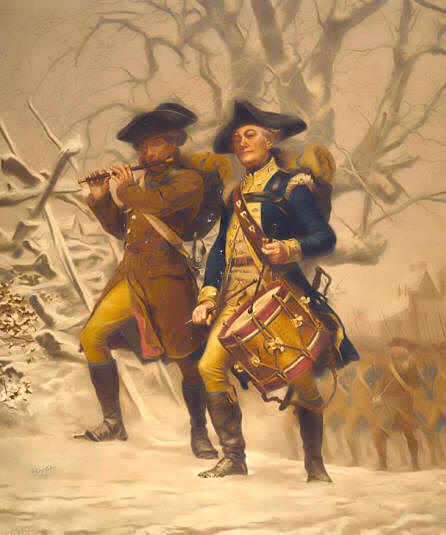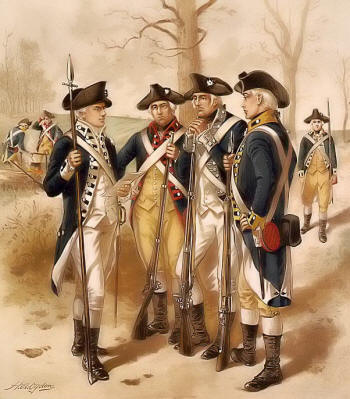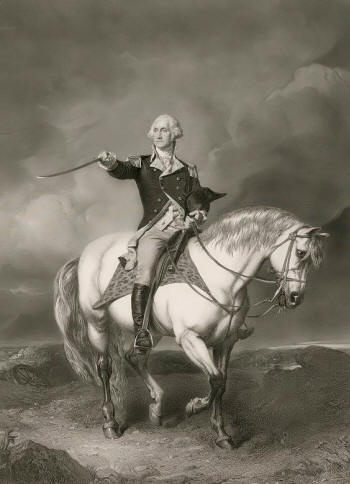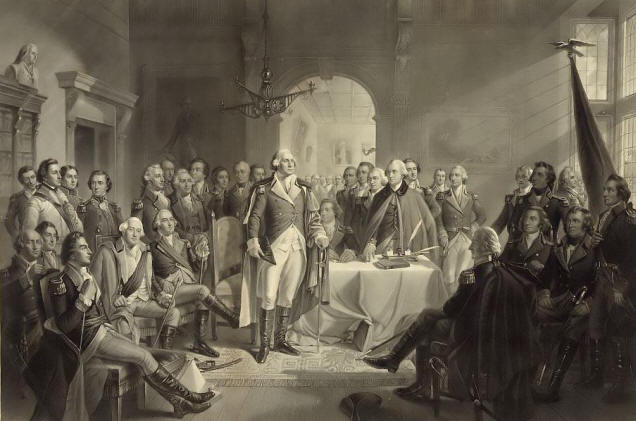The Continental Army
|
|
This Site:
|
The Continental Army, 1776 Continental Army.—On the morning after the affair at Lexington and Concord (April 20, 1775), the Massachusetts Committee of Safety sent a circular letter to all the towns in the province, saying: " We conjure you, by all that is dear, by all that is sacred; we beg and entreat you, as you will answer it to your country, to your consciences, and, above all, to God himself, that you will hasten and arrange, by all possible means, the enlistment of men to form the army, and send them forward to headquarters at Cambridge with that expedition which the vast importance and instant urgency of the affair demands." This call was answered by many people before it reached them. It arose spontaneously out of the depths of their own patriotic hearts. The field, the workshop, the counter, the desk, and even the pulpit, yielded their' tenants, who hurried towards Boston. Many did not wait to change their clothes. They took with them neither money nor food, intent only upon having their firelocks in order. The women on the way opened wide their doors and hearts for the refreshment and encouragement of the patriotic volunteers, and very soon all New England was represented at Cambridge in a motley host of full 20,000 men. On the afternoon of the 20th (April) General Artemas Ward assumed the chief command of the gathering volunteers. The Provincial Congress labored night and day to provide for their organization and support. The second Continental Congress convened at Philadelphia (May 10), and on June 7, in a resolution for a general fast, had spoken for the first time of " the twelve united colonies." General Artemas Ward, of Massachusetts, the senior in command of the provincial militia, assumed the chief command of the volunteers who gathered near Boston after the skirmishes at Lexington and Concord. He was good, but aged, and not possessed of sufficient military ability or personal activity to make an energetic commander of a large army.
In October, 1775, a committee of Congress visited the camp at Cambridge, and, in consultation with Washington and committees of the New England colonies, agreed upon a plan for the reorganization of the besieging army. It was to consist of twenty-six regiments, besides riflemen and artillery. Massachusetts was to furnish sixteen; Connecticut, five; New Hampshire, three; and Rhode Island, two —in all about 20,000 men; the officers to be selected out of those already in the service. It was easier to plan an army than to create one. According to a return submitted to Congress, the Continental army, on the day when the Declaration of Independence was adopted, consisted of 7,754 men present fit for duty, including one regiment of artillery. Their arms were in a wretched condition. Of nearly 1,400 muskets, the firelocks were bad; more than 800 had none at all; and 3,827 --more than half the whole number of infantry—had no bayonets. Of the militia who had been called for, only 800 had joined the camp. With this force Washington was expected to defend an extended line of territory against an army of about 30,000 men. During the encampment at Valley Forge a committee of Congress spent some time with Washington in arranging a plan for the reorganization of the army. By it each battalion of foot, officers included, was to consist of 582 men, arranged in nine companies; the battalion of horse and artillery to be one-third smaller. This would have given the army 60,000 men; but, in reality, it never counted more than half that number. General Greene was appointed quartermaster - general; Jeremiah Wadsworth, of Connecticut, commissary-general; Colonel Scammel, of New Hampshire, adjutant-general; and Baron de Steuben, a Prussian officer, inspector-general. To allay discontents in the army because of the great arrearages of the soldiers' pay, auditors were appointed to adjust all accounts; and each soldier who should serve until the end of the war was promised a gratuity of $80. The officers were promised half-pay for seven years from the conclusion of peace.
George Washington and the Revolutionary War GeneralsIn the spring of 1779, on the report of a committee of Congress, that body proceeded to a new organization of the army. Four regiments of cavalry and artillery, hitherto independent establishments raised at large, were now credited towards the quota of the States in which they had been enlisted. The State quotas were reduced to eighty battalions: Massachusetts to furnish fifteen; Virginia and Pennsylvania, eleven each; Connecticut and Mary-land, eight each; the two Carolinas, six each; New York, five; New Hampshire and New Jersey, three each; Rhode Island, two; and Delaware and Georgia, one each. Congress allowed $200 bounty for each recruit, and the States made large additional offers; but the real amount was small, for at that time the Continental paper money had greatly depreciated. It was found necessary to replenish the regiments by drafts from the militia. The whole force of the American army, exclusive of a few troops in the Southern department, consisted, late in the spring of 1779, of only about 8,600 effective men. At that time the British had 11,000 at New York and 4,000 or 5,000 at Newport, besides a considerable force in the South. In 1780 a committee of Congress, of which General Schuyler was chairman, were long in camp, maturing, with Washing-ton, a plan for another reorganization of the army. Congress agreed to the plan. The remains of sixteen additional battalions were to be disbanded, and the men distributed to the State lines. The army was to consist of fifty regiments of foot, including Hazen's, four regiments of artillery, and one of artificers, with two partisan corps under Annard and Lee. There were to be four other legionary corps, two-thirds horse and one-third foot. All new enlistments were to be " for the war." The officers thrown out by this new arrangement were to be entitled to half-pay for life. The same was promised to all officers who should serve to the end of the war. The army, as so arranged, would consist of 36.000 men; never half that number were in the field. At the beginning of 1781 the sufferings of the Continental soldiers for want of food and clothing was almost unbearable, and there were signs of a prevailing mutinous spirit. Washington knew well their intense suffering and equally intense patriotism, and deeply commiserated their condition. He knew they could be trusted to the last moment, and deprecated the conduct of those who suspected a mutinous spirit in the whole army, and manifested their distrust. When General Heath, with his suspicions alert, employed spies to watch for and report mutinous expressions, Washington wrote to him: " To seem to draw into question the fidelity and firmness of the soldiers, or even to express a doubt of their obedience, may occasion such a relaxation of discipline as would not otherwise exist." The condition of the army was most wretched. A committee of Congress reported that it had been "unpaid for five months; that it seldom had more than six days' provisions in advance, and was on several occasions, for sundry successive days, without meat; that the medical department had neither sugar, coffee, tea, chocolate, wine, nor spirituous liquors of any kind; and that every department of the army was without money, and had not even the shadow of credit left." The clothing of the soldiers was in tatters, and distress of mind and body prevailed everywhere in the service. No wonder that some of the soldiers, who believed that their term of service had expired, mutinied, and marched towards Philadelphia to demand redress from the Congress. It was expected that the immediate disbanding of the army would follow the proclamation of peace. A definitive treaty had not yet been negotiated, and British troops still held New York City. It would not be safe, under such circumstances, to actually disband the army. The Congress therefore decided that the engagements of men enlisted for the war were binding till the treaty of peace was definitely ratified on the recommendation of Washington orders were issued for granting furloughs or discharges at the discretion of the commander-in-chief. Greene was authorized to grant furloughs for North Carolina troops; and the lines of Maryland and Pennsylvania serving under him were ordered to march for their respective States. Three months' pay was to be furnished the furloughed soldiers. They were also to keep their arms and accoutrements as an extra allowance. The furloughs amounted to discharges. Few of the recipients ever returned, and so a great portion of the army was gradually disbanded before the definitive treaty was concluded in September. A remnant of the Continental army remained at West Point under Knox until the British evacuated New York (Nov. 25, 1783). After that event they all received their discharge. The following shows the number of troops furnished by each State for the Continental army:
|
|
|
||
|
|
Site Copyright 2003-2018 Son of the South. For Questions or comments about this collection, contact: paul@sonofthesouth.net |
|
|
Are you Scared and Confused? Read My Snake Story, a story of hope and encouragement, to help you face your fears. |
||


 Soon
after Washington took command of the army the legislature of
Massachusetts and the governor of
Soon
after Washington took command of the army the legislature of
Massachusetts and the governor of
